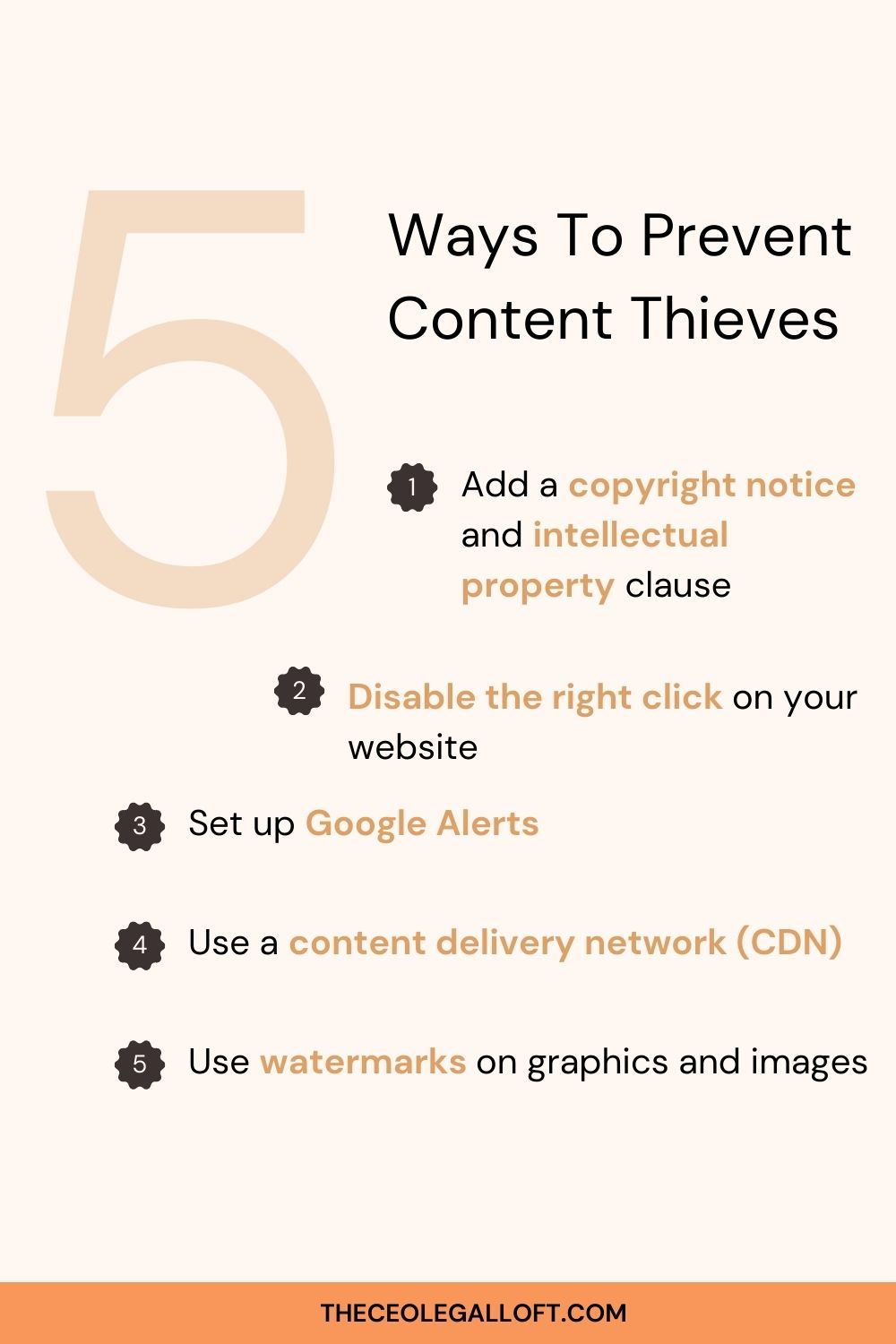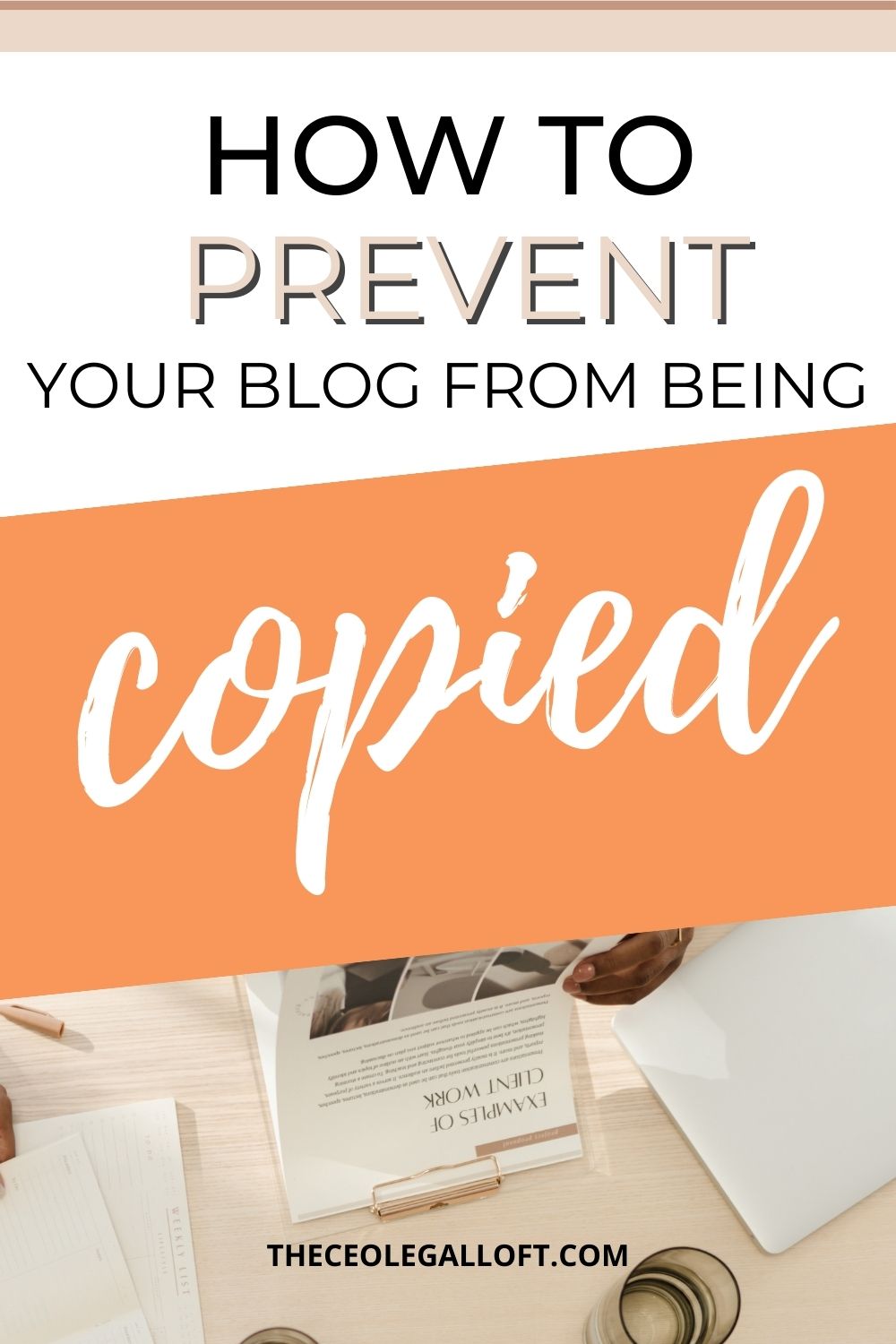Have you ever Googled your blog post title only to find YOUR exact words on someone else’s website?
If you’re nodding your head, you’re not alone. Content theft happens every single day, and as a lawyer I know how frustrating and disheartening it can be. That’s why I am passionate about helping fellow bloggers protect their intellectual property and maintain their hard-earned reputation.
The good news? You can both protect blog content from copying AND take action when someone steals it anyway.
In this comprehensive guide, I’ll show you:
- Steps to remove stolen content from Google search results
- Legal measures to prevent content theft before it happens
- Technical ways to stop blog copying
- Exactly what to do if someone copied your blog post
- How to file a DMCA takedown notice
Table of Contents
- Legal Measures to Protect Your Blog Content
- Technical Solutions to Stop Blog Copying
- Additional Ways to Prevent Content From Being Copied
- What to Do If Someone Copies Your Blog Content
- Dealing with Content Theft on Social Media
- Handling AI-Rewritten Content Theft
- Final Thoughts
Legal Measures to Protect Your Blog Content
Add a copyright notice
Adding a copyright notice to your blog is one of the simplest yet most effective ways to prevent content theft. A copyright notice serves as a public declaration that your content is protected and cannot be used without permission.
What to Include in Your Copyright Notice:
- The copyright symbol (©)
- Year of publication or creation
- Your name or business entity
Example: © 2020-2024, [Your Name/Business], All rights reserved.
Display your copyright notice prominently in your website footer to stop blog copying before it starts. This visible reminder can deter casual content thieves and provides legal proof of ownership if you need to file a DMCA takedown later.
Add an intellectual property clause
An intellectual property (IP) clause takes your content protection to the next level. Unlike a simple copyright notice, an IP clause specifically outlines how others may (or may not) use your content. This legal language becomes crucial when you need to report copyright infringement.
An IP clause might include the following:
- A statement that all content on the website is the property of the website owner.
- An explanation of the types of content that are protected by copyright, such as text, images, videos, and graphics.
- Information on how visitors can use the content, such as for personal, non-commercial use only.
- A statement that visitors cannot use the content for any other purpose without permission from the website owner.
- A description of how the website owner will enforce their intellectual property rights, such as sending DMCA takedown notices or pursuing legal action against infringers.
Include your IP clause in your Terms and Conditions or create a separate “Copyright Policy” page. Link to this page from your footer to ensure visitors understand that copying blog content without permission has legal consequences.
Technical Solutions to Stop Blog Copying
By including an IP clause in your terms and conditions agreement, you can help protect your intellectual property and make it clear to your website visitors what they can and cannot do with your content. It also helps to provide a legal basis for pursuing legal action if someone infringes on your rights.
A copyright notice and intellectual property clause can help protect your work from being used without permission and ensure that you get credit and compensation if it is used. Furthermore, they allow you to preserve the integrity of your work so that it remains true to its original purpose.

Disable Right Click
When you disable the right-click function on your blog, you prevent visitors from accessing the context menu that allows them to copy and paste your text or save images. This can be an effective way to deter casual copying, as most visitors will not know how to copy content without the right-click function.
Disabling the right-click function can be achieved using plugins or coding, depending on the platform you are using. For example, if you’re using WordPress, you can install a plugin such as “WP Content Copy Protection Plugin” or “NoRightClick Images Plugin”. These plugins will disable right-clicking on your blog and prevent visitors from being able to copy your content or save images.
If you’re comfortable with coding, you can also disable right-clicking using HTML or JavaScript. For example, you can add the following code to your website’s header to disable right-clicking:
<script> document.addEventListener(‘contextmenu’, event => event.preventDefault()); </script>
Disabling the right-click function won’t completely prevent content theft, and someone who really wants to steal from you will by using other methods. However, it can be an effective way to deter casual copying and make it more difficult for visitors to use your content without your consent.
Set up Google Alerts
Setting up Google Alerts is a useful way to monitor your original content and detect any instances of someone who steals content. Here’s how you can set up Google Alerts to prevent website content from being copied:
- Go to the Google Alerts website.
- Enter your search terms: In the search bar, enter the title or main keywords of your blog post. You can also use quotes to search for an exact phrase.
- Choose your options: Under “Show options,” you can customize your alerts by selecting the sources, frequency, language, region, and how many results you want to receive. You can also choose to receive alerts as they happen, once a day, or once a week.
- Set up your alerts: Once you’ve chosen your options, click “Create Alert” to set up your alert. You can set up multiple alerts for each of your blog posts or for different variations of your search terms.
- Monitor your alerts: You will receive email alerts whenever Google detects new content that matches your search terms. When you receive an alert, review the content and check for any instances of plagiarism or copying. If you find any, you can take the necessary steps to have the content removed or file a DMCA takedown notice.
Setting up Google Alerts is a straightforward and effective way to monitor your blog content and detect any instances of it being copied or plagiarized. By monitoring your content regularly, you can take proactive measures to prevent content from being stolen and maintain the integrity of your blog.

Use a content delivery network (CDN)
A CDN is a network of servers located in various geographic locations around the world. When you use a CDN, your blog content is cached (stored) on these servers. When a user requests your piece of content, the CDN will serve the content from the server that is closest to the user’s location, which can improve the loading speed and performance of your website.
In terms of content protection, using a CDN can make it more difficult for content thieves to steal your blog content. This is because your content is not stored on a single server, but on multiple servers distributed globally. If someone attempts to steal your content, they will need to access and copy it from multiple servers, which can be a time-consuming and difficult process.
Additionally, a CDN can also help protect your website from Distributed Denial of Service (DDoS) attacks, which can be used to overwhelm your website with traffic and bring it down. By distributing your website’s content across multiple servers, a CDN can help mitigate the effects of a DDoS attack and keep your website online.
To use a CDN, you can sign up for a service such as Cloudflare, Amazon CloudFront, or Akamai. These services offer various plans and pricing options, and can help improve the performance and security of your website.
There are hosts that also include this in their services. The host for my firm website, Siteground, has it as a service.
In summary, using a CDN can help prevent content theft by distributing it across multiple servers, making it more difficult for someone to steal. It can also improve the performance and security of your website, making it a valuable tool to protect website content for any blogger or website owner.

Use watermarking
Watermarking is a technique used to add a visible overlay to images and graphics to help deter copying and protect your intellectual property. Watermarks can include your logo, copyright symbol, or website URL, and are typically placed over the main content of the image or graphic.
Adding a watermark to your images and graphics can make it more difficult for others to steal your content, as the watermark will make it clear that the content is your intellectual property. Watermarks can also help with brand recognition, as your logo or website URL will be prominently displayed on the image.
There are many ways to add watermarks to your images and graphics. Here are some common methods:
- Manual: You can add a watermark manually to your images and graphics using an image editing tool such as Adobe Photoshop or Canva. This can be time-consuming, but allows for full customization of the watermark.
- Using a plugin or tool: Many blogging platforms and image hosting services offer watermarking tools or plugins that allow you to add a watermark to your images automatically. This is a quick and easy way to add a watermark, but may not allow for full customization.
- Using an online service: There are many online watermarking services that allow you to add a watermark to your images and graphics without the need for software. These services typically offer a range of customization options and are easy to use.
When adding a watermark to your images and graphics, it’s important to make sure that the mark is clearly visible and does not obscure the main content of the image. The mark should also be placed in a location that makes it difficult to crop or remove.
What to Do If Someone Copies Your Blog Content
Finding out someone stole your content can be incredibly frustrating, but taking swift action can protect your work and search rankings. Don’t panic – there’s a proven process to follow when you discover someone copied your blog post. The key is to act methodically and document everything along the way.
Step 1: Document the Content Theft
Before you can report copied content, you need solid evidence. Time is of the essence here, as content thieves may change or remove the stolen content once they realize they’ve been caught. Quick and thorough documentation protects your rights and strengthens any legal action you might need to take.
Start by taking screenshots of the copied blog post with timestamps included. Save the full URL where your content was stolen and use the Wayback Machine to create an archived version of the theft. Record exactly what percentage of your content was copied and note the publish date on both your original post and theirs – this proves they copied you, not the other way around.
Pro tip: Use tools like Copyscape to search for other instances where the same person might have stolen your blog content across multiple websites. Sometimes content thieves target several of your posts at once.
Step 2: Identify the Content Thief
To stop someone from copying your content, you need to know who to contact. This detective work is essential for the DMCA takedown process and can mean the difference between quick resolution and prolonged frustration.
Start with a WHOIS lookup to find domain owner details. Services like whois.net, who.is, and domaintools.com can reveal the website owner’s contact information. If the WHOIS data is private (which is increasingly common), don’t give up. Check the website itself for contact pages, about sections, or privacy policies that might contain contact information. As a last resort, use tools like whoishostingthis.com to identify their hosting provider – hosts are legally required to forward DMCA notices to their clients.
Step 3: Send a DMCA Takedown Notice
A DMCA takedown notice is your legal weapon to remove stolen content. This formal request carries legal weight and most website owners and hosting companies take them seriously to avoid liability.
Before jumping to a formal DMCA, try direct contact first. Send a polite but firm email to the content thief requesting removal of your stolen blog post. Give them 48-72 hours to respond – sometimes this approach resolves the issue without needing formal legal notices. Many people who copy content don’t fully understand copyright law and will comply once contacted.
If direct contact fails, proceed with a formal DMCA takedown notice. Your notice must include:
- Your contact information
- A description of your original work
- The URL of your original blog content
- The URL of the copied content
- A statement of good faith belief that the use is unauthorized
- A statement under penalty of perjury that you own the copyright
- Your physical or electronic signature.
Step 4: DMCA Timeline
Understanding the typical response timeline helps you protect your blog content effectively. Send your initial DMCA notice on day one, then follow up on day three if you haven’t received a response. By day seven, if the site owner hasn’t acted, escalate to their hosting provider with your DMCA notice. Around day ten, if the content remains online, file removal requests with search engines. If valuable content remains stolen after two weeks, consider consulting with an intellectual property attorney.
Most reputable hosting companies act quickly on valid DMCA takedown notices to avoid liability under the safe harbor provisions of the DMCA. They typically give their clients 24-48 hours to respond before taking down the content. Remember to stay professional throughout this process – your goal is to remove copied content, not to escalate into a lengthy legal battle.
The most important thing to remember when dealing with content theft is that you have rights as a content creator. Don’t let frustration paralyze you into inaction. Follow these steps systematically, and you’ll successfully stop content theft in most cases. Your original work deserves protection, and now you know exactly how to defend it.
Conclusion: Protect your website content from copying
As a blogger, I know how much effort and passion goes into creating unique and valuable content for your readers. It can be incredibly disheartening to see your hard work being copied or stolen by others. That’s why I want to share some practical tips on how you can protect your blog content and maintain your intellectual property rights.
While these measures can help your website content from being copied, it’s important to remember that they are not guaranteed. However, by taking these proactive steps, you can help protect your hard work and maintain the integrity of your blog.
And if you ever find your stolen content on someone else’s website or social media platform, you can use The Brand Protector. This mini bundle includes the exact template I use to get my client’s stolen content taken down.

Wow! I’ve never even though about disabling right click. Just added the code to my site to this and it worked perfectly. Thanks!
Yay! I’m glad. 😀